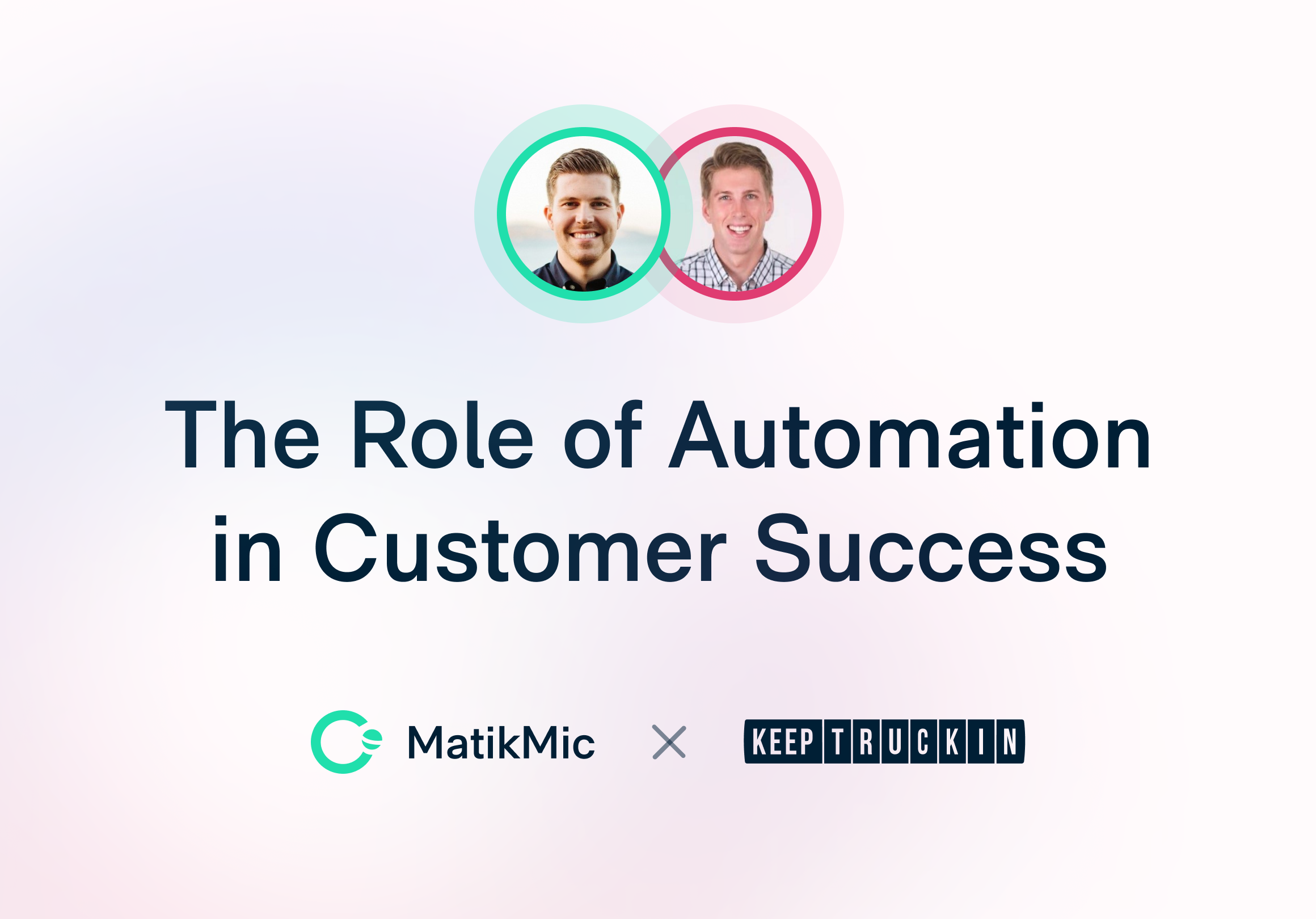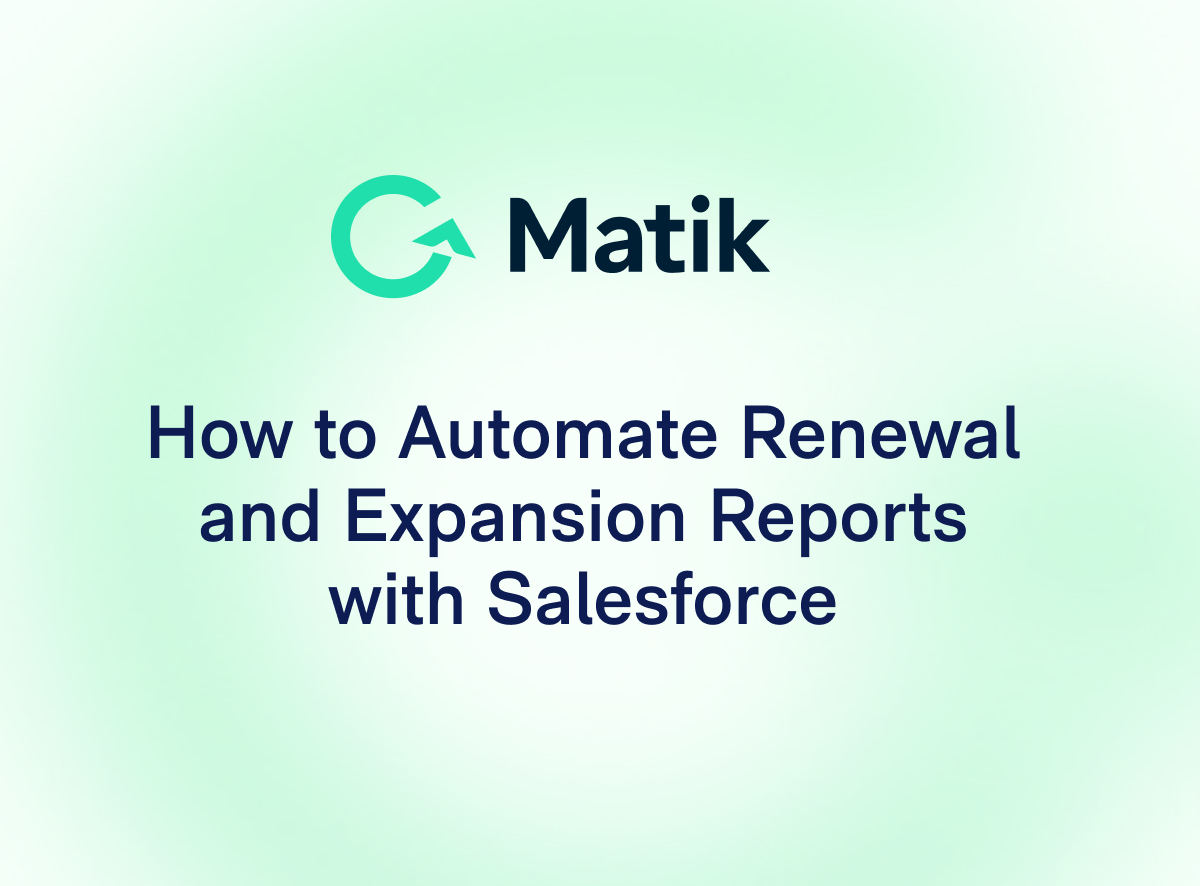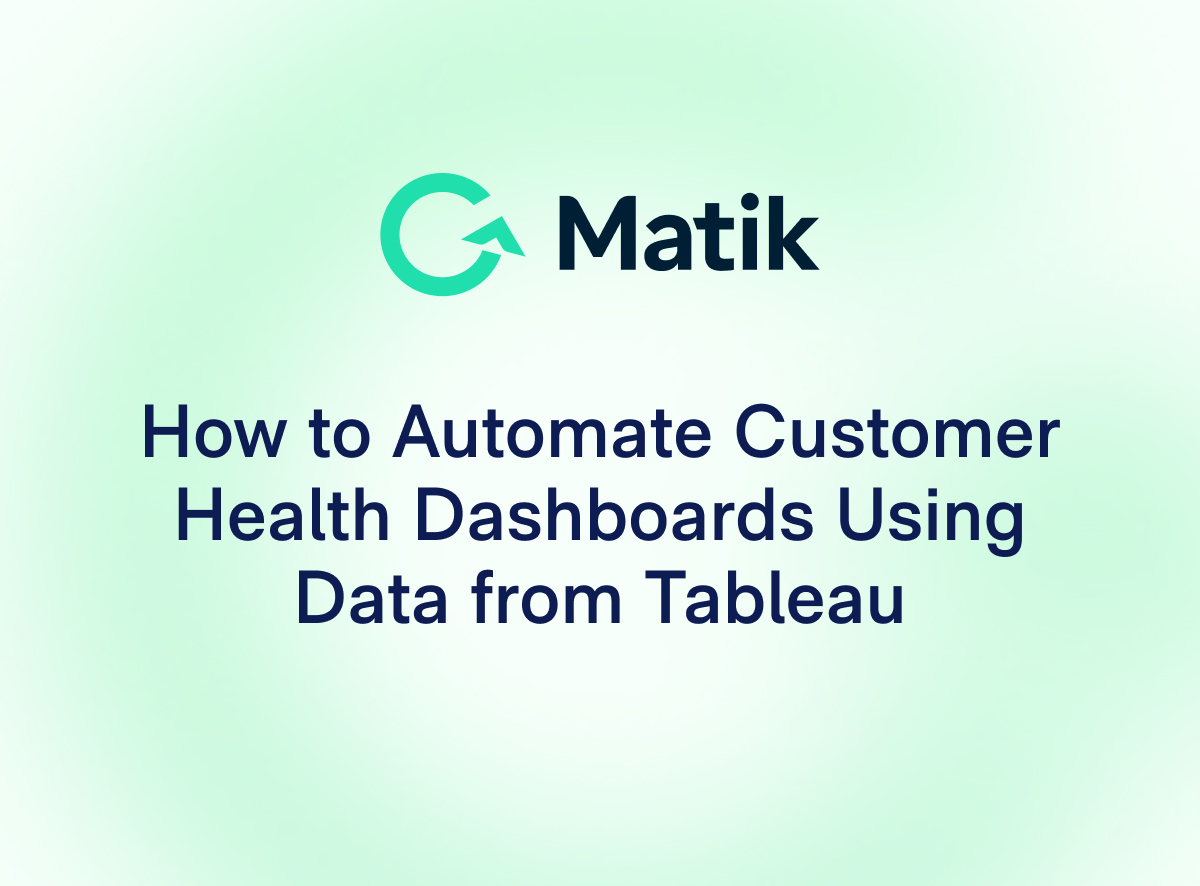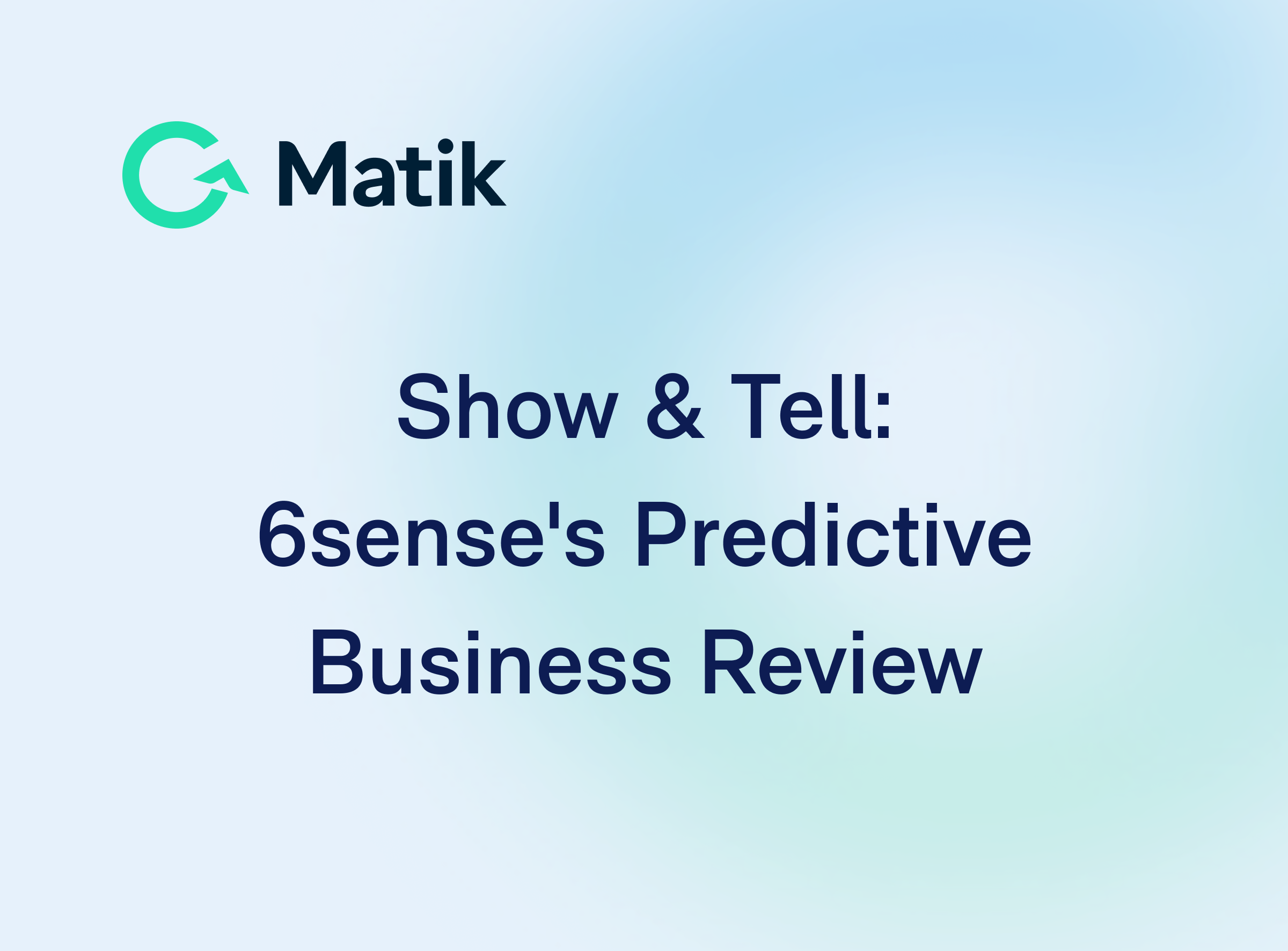Join Our Newsletter
Read the transcript of "Matik Mic," where we chat with John Gleeson, Head of Customer Success at KeepTruckin, about the role that automation has played in helping his team reach their customers at scale.
Episode Highlights:
Nik Mijic:
We’ve got John Gleeson here today, Head of Customer Success at KeepTruckin. Please introduce yourself and tell us a little bit more about KeepTruckin.
John Gleeson:
KeepTruckin is a startup and we brought a good portion of the trucking industry online. We help fleets with everything from compliance to safety, and allow them to run in a data-driven way - many of them for the very first time.
It's been quite the trip, I joined when we were pretty small. We were about a million dollars in ARR, and now we're well over 100M. It's been quite the journey.
In terms of customer success, where do you feel like the CS industry is going and how do you feel like it's been impacted with COVID today?
Well, there's a lot to unpack there! First things first, with COVID, I think it's been important for relationships with your customers to be extra meaningful, extra caring, and extra thoughtful.
The reason for that is a lot of businesses are faced with some pretty difficult decisions right now. Certainly, some businesses are riding great tailwinds from COVID, but others aren't.
Regardless, whether you're up or whether you're down, you're looking out at the world saying, "okay, I want to run my business in a more efficient way than before. The good times might not last for forever. So I want to make sure that I'm ready for whatever comes my way in my business."
As a vendor, now more than ever, you want to make sure that your customers see your value. There's no room anymore for "nice-to-haves" in folks' tech stacks. Everything has to provide value.
I want to ask you about the role of data and how you use it to prove out your value. How do you arm your team with data, and what does that process look like?
First things first, I think there's such an intertwined relationship between customer success and sales. I actually came up through the sales organization, so when you lift the hood on my customer success operation, you'll notice that there certainly is a bit of a sales mindset there.
I think sometimes the best defense is a good offense. In sales, it comes down to the fact that people buy because something can either save them time or make them more money. And generally, if you save time, you're gonna make more money.
You have to use data to tell that story. Find examples of things that your product is doing for your customer. Start early to capture where that time savings is, where that money savings is, etc.
Establish that this is something that you're going to work to improve, and then use data to report that back to the customer every step of the way. When you get to the end of your contract, you can highlight the progress in that journey.
You really have to make everything quantifiable, and the only way you can do that is with solid, predictable and repeatable data.
How has the CS org developed within KeepTruckin over the years that you've been there?
At first, in anything, you're very much doing things that maybe don't scale. There's these Hail Mary plays that you're throwing, because so much is coming at you so quick, you just have to deal with it.
You're actually very familiar with our industry, since your parents also went through this mandate that happened in 2017, where basically every truck driver in America was required to have a tracking device onboard.
We knew this date was coming. We had planned for it. But we never expected how much we would get flooded. We really, really got flooded. As much as we planned, we were still overwhelmed for a minute. We were certainly throwing a lot of Hail Mary plays.
But we came out on top of that, and it ended pretty well for us. That's when you really start to get some congruence in how you run your operation and you start to do things that are more scalable. The way that we did that was through the Executive Business Review (EBR).
The reason we started doing EBRs was because, when this mandate happened, the buying decision in a lot of accounts was actually pushed down lower than previously, because companies had to make decisions quickly.
We knew that we had one year to prove value and drive the relationship back up in the account. We needed to make those EBRs in a very scalable way, so that we could touch all of our customers, hopefully, two or three times before their renewal with a meaningful progress report.
Finding ways to make things that feel pretty manual (like EBRs) a little bit easier is certainly one of the many evolutions in our organization.
How has the data within those key EBRs evolved? How have you guys grown to adapt new insights and new data points within the customer journey?
Well, you've been pretty close to that. So you would know, one of the by-products of a company that experienced hyper growth is that every single data point internally is a mess.
When we started to get data in these EBRs, we were looking for any sort of data so long as it was accurate and we could produce it again and again. We started small, it was some data around just like basic compliance, things like that.
Now, as we've evolved, our data has gotten a little bit more organized, and certainly, you've lifted the hood on that, and you've been helpful. But we're starting to leverage all of the different things that are in our products, all of the data that they spit off.
For folks who don't know, we sell what's called an ELD. Think of it as a little computer that goes inside a track accelerometer, gyroscope, Bluetooth, all of the same things that are in your cell phone, are moving around in a truck around America every day.
So the amount of data that that spits off is incredible: from the speed that the truck is going, to how fast they stop. Add on a dash cam - a little camera on the dash of a truck - so we can see what's happening outside. Again, that's more data to layer in.
Now we've got this full 360 view. So with our EBRs, a fleet can make a ton of decisions. From, “should we give this load to this driver because they want to get home for Christmas,” through “Do you know what? Maybe we should manage this driver out, because we've seen time and time again that they're not a very safe driver.”
I think that's probably why we fell in love with Matik so quickly. When you look around at all of the tools that are available to help customer success people, there's a lot of tools around quick response time or flagging unhealthy accounts.
That's really important, don't get me wrong. But I think where the magic in a great Customer Success program comes out, is when you can truly make a customer feel like you went above and beyond for them, or you did something truly special for them.
Putting together a data-driven Executive Business Review takes time, it takes a lot of preparation. Customers recognize that, “wow, a lot was curated here.” With a tool like Matik's customer success presentation software, you can do that at scale.
The customer doesn't need to know that there's a magical solution that's allowing you to make it look like you really went above and beyond for them. You need to find tactics like that in your business to provide that service that feels really, really special, and highlights just how much you care. I guess that's why we fell in love with you guys.
Where do you see automation going in the future with customer success?
When you think about the best customer success programs, they really intertwine great human interaction with great automation. And those workflows can be complex.
The world is so trained to have everything they need at their fingertips. I think about the raspberries that I buy on Amazon. I don't know if you buy raspberries, but raspberries are a ticking time bomb.
You never know when you're going to get that moldy raspberry, but there's always one and it's always like, ah, shucks, man, it got moldy. But with Amazon, you don't even have to send a picture of it, you just send them “moldy raspberry” and you're automatically credited back.
That's the experience that people have come to expect in their personal lives. And that trickles over to their business lives as well. Our personal lives and our business lives are very intertwined these days.
So I think the best customer success programs are the ones that make the little things very, very easy through automation. Then, when it kind of comes time to having a relationship, the people can focus on the people - that can create a lot of stickiness.
I think the future, and certainly what we're building towards is one with easy automation and easy workflows, that actually avoid a lot of human interaction upfront.
When it comes time for there to be a human interaction, there can be a lot more energy put into expansion, ROI proving, things like that. So customer success truly can be an offense play.
---
See Matik in Action—Request a Demo















